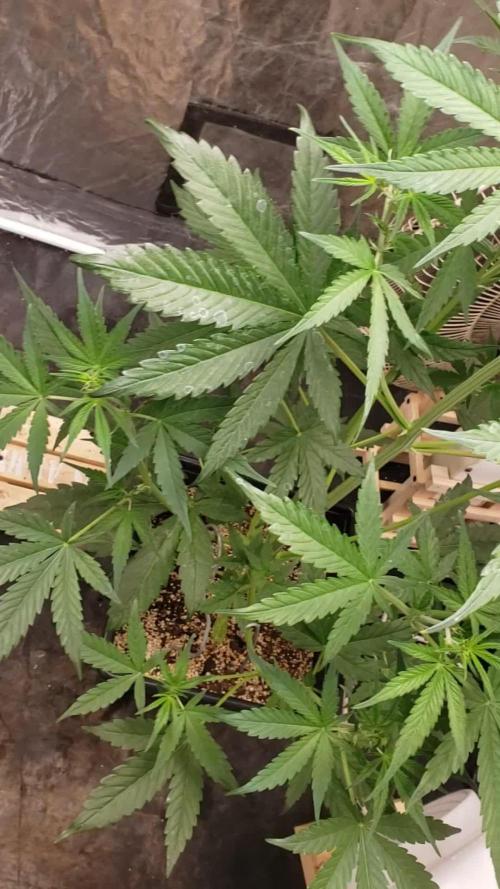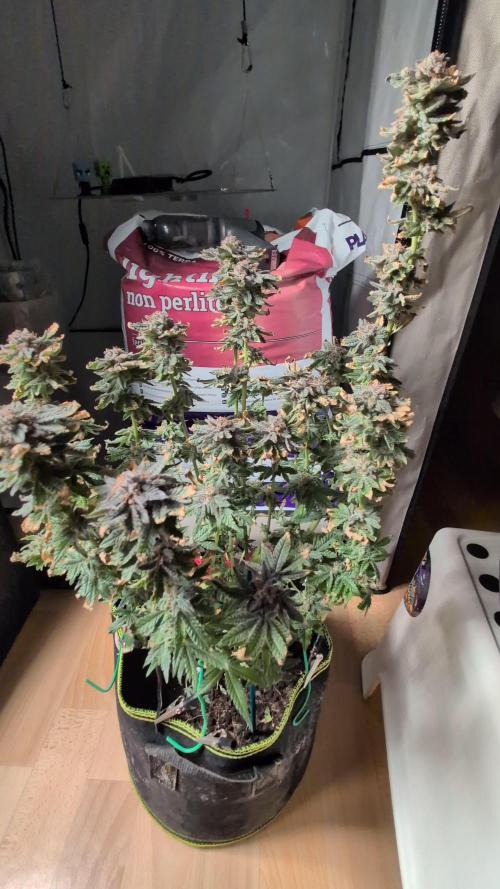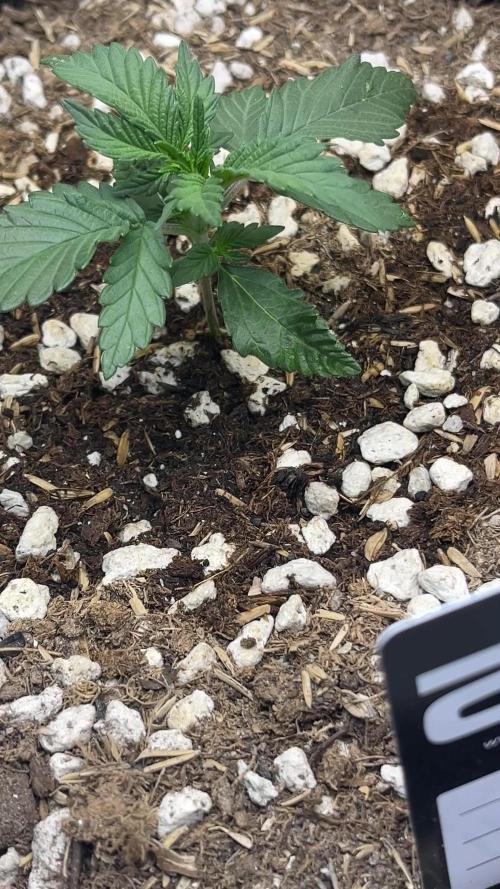The Grow Awards 2026 🏆 

































Likes
Comments
Share


@SooSan
Follow
120w :
- 2xQBmini lm301b 3000k + Far Red
- Spyder Lm301h 3500k + Emerson
Box 50x50x100
Double Scrog Vertical
Tropical Fuel 32g
Afghan Peach x Blue Monkey 26g
Hindu Kush 25g
Gelato Cake 33g
Fast Critical Poison 27g
(Blueberry x Black Domina) X (Kosher Kush x Mk-Ultra) 13g
(Blueberry x Black Domina) X (Kosher Kush x Mk-Ultra) 4g
Blueberry 3,5g
Herz OG 4,5g
120w = 168g
Likes
5
Share


@Deltatigrou0169
Follow
Bonjour à tous,
Voilà les nouvelles d'aujourd'hui, Très content mes fifilles poussent de jour en jour (normal) je les regarde grandir tout les jours et toujours avec autant d'amour je les aimes mes Fifilles 😊.
J'espère que mes petites Mutantes vont pousser correctement, à voir 🙂 je vous à plus tard et bonne journée à tous les Amis 😉👍👍👍
Likes
14
Share


@Targona
Follow
Targona: 29 days since my little girl sprouted from seeds🌱
Fourth week of growth of my OG Eddy Lepp Auto 💚🌺💚🌺
Nutrients:
I use nutrients from Advanced Hydroponics Of Holland - three basic components, still according to the table for growth during the flowering period 💓 -
- Dutch fertilizer Formula 1 Grow - supplies the plant with substances necessary for the perfect development of roots, stem and leaves; intended for the growth phase 🌾
- Dutch fertilizer Formula 2 Bloom - contains a large amount of nutrients necessary for rapid growth and fruit development, supplies the plant with energy; intended for the flowering phase 🌸🌿
- Dutch fertilizer Formula 3 Micro - increases oxygen intake, improves plant immunity, ensures better absorption of nutrients; intended for the growth and flowering phase 🌴
-------------------------------------------------------------------------------------
Plagron Power Roots - Root Stimulator Plagron Roots is a biological root stimulator that supports the formation of the root system. I use it until the fifth week of growth 🍃🍃 - I fertilize for the last time in the fifth week of plant growth.
-------------------------------------------------- -------------------------------------------------- --------
BioBizz Calmag - The special Calmag supplement was designed for professional and hobby growers who need to supply their plants with calcium and magnesium in organic quality for a long time or immediately. The 100% organic 💩💩 and certified BioBizz Calmag product is made of calcium carbonate and magnesium sulfate supplemented with humic acid.
-------------------------------------------------- -------------------------------------------------- --------
BioBizz Bio pH - is an organic pH regulator. An aqueous solution of citric acid, which occurs naturally in citrus fruits 🍋🍋
------------------------------------------------------------------- ----------------------------------------------
During the flowering period, I add Advanced Nutrients stimulants:
- JUNGLE X Environ is a highly effective complex preparation for stimulating flower formation. 🌸🏵️
- Bud Candy - carbohydrates for my girls 🍭🍭🍭
⚡⚡⚡However - from the next watering I will fundamentally change the nutrients to organic with small exceptions. I will make this change carefully, so that the girls feel good, have the nutrients they need and at the same time not give them so much synthetics ⚡⚡⚡
General:
OG Eddy Lepp Auto 💚🌺💚🌺 - The girl is growing beautifully and responds well to nutrients. In the last week she switched to the flowering phase and therefore grew tall, even though it is a hybrid.🌿💚
Training:
Classic, I continuously perform defoliation and small LST - I tie up the branches that grow towards the pot just like the others so that they do not shade each other's buds. In addition, I gently pulled the large leaves closer to the stem so that I don't have to cut them 💚🌞🌞
Light: Mars Hydro TS1000 The plants respond effectively and the light is technically very well managed - I try to have 50 cm between the light and the plants, so I regularly move it up 💡💡💡
Thanks for the likes :)
See you soon 😍😍
Likes
9
Share


@newenglandgrowers
Follow
Cut the plants down on the 24th of April, drying room levels are 72°F and around 60%RH, I'm currently on Day #14 of drying and the buds don't feel fully dry yet, the main tops feel crunchy and dry but the lower smaller buds are still quite moist and smell like chlorophyll, I think I may harvest the main tops so I don't overdry and leave the rest in the tent for another few days, either that or put the rest of the buds in a brown paper bag to finish drying. Finished dry trimming the plant ended up with 200 grams dry weight not including trim there's another 2 ounces of trim which if you want to include that would bring the total weight from this 250W LED to 256 grams. I'm super happy with the result of this especially for my first grow and from one autoflower, it can only get better from here on out. FYI Not sure why I can't edit the lights I used but the bloomgro 600W LED is PULLING AN ACTUAL 250W FROM THE WALL so the gram/watt should be .8g/W
Likes
6
Share


@Roberts
Follow
White widow is doing great compared to her start. She has bounced back well. She will be huge by the time I get her to her finish. Things are looking good now. Thank you Seedsman, Medic Grow, and Athena.🤜🏻🤛🏻🌱🌱🌱
❄️🌱🍻 https://www.seedsman.com/?a_aid=Mrsour420. This is my affiliate link to seedsman.
Thank you grow diaries community for the 👇likes👇, follows, comments, and subscriptions on my YouTube channel👇.
❄️🌱🍻 Happy Growing 🌱🌱🌱
https://youtube.com/channel/UCAhN7yRzWLpcaRHhMIQ7X4g.
Likes
Comments
Share


@The_Doctor_Green
Follow
Hola a todos! Espero que anden bien!!..
Les comento que hice esta semana, la he regado con agua un riego y el último hoy, con nutrientes en sus dosis indicadas más arriba.
La planta ha crecido mucho esta semana 37cm en 7 días, ha pegado el estirón, y también han mostrado sus preflores.
Esta semana he tenido una humedad alta 70% y no la he podido bajar,pero con humedad y una temperatura que ha rozado los 28 grados por momentos, he notado que las plantas les gusta ese ambiente, por eso el crecimiento que ha pegado.
Hoy (17/09 ) ,dia 35, de la Auto Divine Rapier he quitado las hojas más grandes que tapaban las ramas bajas, espero que en este momento no estrese la planta.
Bueno, no los aburro más, nos vemos la próxima semana!.
Buenos humos!!
Las imágenes corresponden al periodo del 10/09 hasta el 17/09 (dia 35) inclusive.
Likes
Comments
Share


@OnePrettyFlyGuy
Follow
Something tried to nibble on Plant B, however there are no signs of pests and no further damage anywhere else (I have 6 other plants in the garden too). Plant A has already begun to develop stipules on its first set of true leaves too!
Had their first feed on day 14 (2ml Fish Mix + 0.1ml Mono-silicic Acid), and were fed again on day 16 (2ml Fish Mix, 2ml Bio-Grow, 2ml Bio-Bloom, 0.1ml Mono-Silicic Acid).
Likes
21
Share


@Shaunofthedank
Follow
Plants responded well to topping/fimming. They all have 4/6 main stems. Training them to get a bit of a canopy going. Cookies kush is def a keeper. Gonna try clone it. My clone games weak though.
Likes
3
Share


@hayzerii
Follow
I think i might did cut off too much leaves, but idk :( some advice would be nice, or just tell me your opinion :D
Likes
32
Share


@TOTEM
Follow
Everything fine!
She’s getting bigger, and her roots too, because when I give her water, she doesn’t bend around anymore.
Day 15 (April 26, 2019): she was hungry, she got food! Exactly like a Queen. 👱♀️🏻👗👑
Day 19 (April 30, 2019): topped over the 3rd node.
Day 21 (May 2, 2019): removed the 1st node and started a 4-way LST.
Processing
Likes
20
Share


@mikemobes
Follow
9/2
-Cream Cookies Trichomes at 90% Clear, 10% Cloudy, 0% Amber. Im a lover of a good heavy indica and usually allow the plant to mature until it reaches 0% Clear, 90% Cloudy, 10% Amber.
-Cheese is towering some main cola sites with thick flower development. Going to develop into massive colas. (Cheese has historically taken 2 weeks longer than other plants to mature and is around 2 weeks behind cream cookies. There is still a possibility she explodes with flowering growth in the coming week.)
-Lowering dose of nutrients to 12 mL/gal until harvest.
9/3
-Cream Cookies is beginning to change color and dump its fan leaves. Going to allow the plant to do its thing. Don't want to cut the leaves early as the plant is most likely using those fan leaves as a source for mobile nutrients for the rest of the plant. Going to let nature keep its "nutrient batteries" if you will. The plant built up its healthy leaves only to use them later when it doesn't need them anymore. I love nature and the cycle of plant life. Just mesmerizing.
9/4
-Rotated the plants so I could get a better vantage point for cheese and holy shit. Cheese has grown so thick that a major major defoliation was needed just to expose slightly under the canopy to some light. The plant is also growing absolutely huge colas. HUGE. like 8-10 inch colas with flowering buds thickly covering the stem. On these colas you can't even see stem. Im so excited what a pleasant surprise
-Cream cookies is beginning to change colors indicating its entering the final stages of flower and is on par to be harvested right at the beginning of week 13.
9/6
-Rigorous defoliation done on both Cheese and Cream Cookies.
-Beatiful aromas are dominating my dwelling. Gotta love the natural dankness smell. Ahh home sweet home. Anyway both plants are developing extremely well.
-Cheese is towering and developing later kind of, weird growth pattern but if it produces dank thick colas ill be very happy. Cheese is definitely going to stay flowering longer than her sister cream cookies who I'm going to flush next week and harvest in 7 days! Very excited.
-Cream Cookies buds are developing very nicely. Accidentaly forgot to raise the lamp 2 inches and as a result the plant got a little stressed and one of the buds got a little light burn on its baby fan leaves but no actual bud damage. Going to leave the leaves on until they begin to become an issue.
Likes
51
Share


@Silverback_Guerilla
Follow
I harvested them about a week apart. Neither one was as bulky as I hoped for, but they both frosted over incredibly well and smell a little bit like black cherry (one of the genetic donors)..but it's also a little like a burgundy wine flavor on the exhale. Very appropriately named!
Plant A: 80g
Plant B: 88g
It's dried up into some really tight, beautifully dense nuggs. Between both plants I got about another 30g's of lower/larfy bud that I'll press for the rosin in another day or two.
This strain is pure magic to grow...nothing to it really. They happily eat up whatever nutes you give them and aren't light-sensitive in the least.
They stretched a little more than 3 feet from the time they were switched to flower and both plants reached 4' in total. Slightly more space between the nodes than the Sucrose Overdose, but they filled in nicely. They have a very mild aroma while growing, but it smells delightful in a jar. One pheno had "praying" fan leaves from the get-go, all the way to the end...never drooped..not even at night. It didn't have the more red coloration in the foliage and stems like the other one. But a real beauty just the same.😍
I still have one of these beans that I'll run next Fall..and prolly clone the hell out of it..👍.
Special thanks to Wicked_Stix for his idea to breed this hybrid, and the magic beans!!!!!!
I'll update with my smoke test and final thoughts next week some time.
Likes
2
Share


@UnitedStrainsGermany
Follow
Es wird jetzt in den Dryfembags getrocknet, aber es sind max 30g trocken
Likes
Comments
Share


@LokalGrenz
Follow
Purple Haze is showing really healthy early-veg structure. The new growth at the top is tight and stacked, which means she’s preparing to push upward soon. Leaf color is a deep, healthy green with absolutely no signs of burn or twist. The leaves are wide and strong, showing she’s getting enough light without being stressed.
The plant looks slightly fuller and more compact compared to Gorilla Cookies, which is normal—Purple Haze autos often grow bushier early on. Stem looks strong and upright with no stretch.
Likes
228
Share


@StarLorr
Follow
Welcome to my Pablø Ęscøbar diary.
In this diary:
Seeds: sponsored by Ðivine Șeeds
Media: Promix HP
Nutrients: Advanced Nutrients, Diablo Nutrients, Gaia Green Power Bloom.
Light and Weather: Şun☀️and Mother Earth.🌎
___________________________
Feeding:
Tue 17Sep: 8L water not pH'd
Thu 19Sep: 4L Flawless Finish not pH'd
Fri 20Sep: 4L Flawless Finish not pH'd
Sat 21Sep:4L water not pH'd
___________________________
*please note that watering are from the top.....since i smashed the saucers with the weed wacker*🤦🏻♂️
______________________________
Amazing weather throughout the week! Again☀️Sunny 26°C 😎"Except for today Monday 23-Sep-24 as per cloudy☁️photoshoot🙃😄
______________________________
Did my flushing thing, it's happening😉
______________________________
Thanks for stopping by, likes and comments are appreciated!👊🏻😎
Keep on growin!
Keep on tokin!!!
😙💨💨💨💨💨
Likes
23
Share


@PapasGrow
Follow
Girl Scout Cookies XTRM 🍪❄️
From AMS - Amsterdam Marijuana Seeds 🌱
Lights by MarsHydro FC3000 🚀🚀
Tent - 100x100x180 Mars Hydro 🏕️
From Www.Mars-hydro.com
2xScrog used on GSC XTRM. She is extreme indeed. 🍪✨
Green house feedings are keeping it simple!🏆
+ Tested out Hesi Boost. ⚡
Flowering week 8 ✅
For final weeks moved out of tent to max out her potential in the flowering room.
Likes
35
Share


@DevilsBud
Follow
Start of week 6
The hedgehog on the 2 sins are insane and now it's time to pump ul the volume everything going great and the smell is very unique
visit www.marshydro.eu
for your best gear and use the PROMO CODE: DEVILSBUD
Some info about the Marshydro FC-4800
Superb Quality LED Chips: The whole light is composed of 1206 pcs Samsung lm301b and Osram 660nm chips. More than two times as many LEDs are used to drive the grow lights at low currents and to avoid overdrive. Quality is guaranteed and efficiency is up to 2.8 μmol/j.
Even PAR Distribution and High PPFD Output: The multi-light bar design and the densely distributed light chips enable the LED grow lights to achieve the optimum PPFD required for plant growth over the entire effective coverage area.
Specifically Designed Spectrum: To ensure even plant growth, blue and red light are enhanced on the basis of a full spectrum combination. Not only does this accelerate plant growth, but it also improves the yield and quality of the plants at the same time.
Dimming Daisy Chain Function: The dimming function saves on electricity costs and enables brightness from 10% to 100% for the different stages of plant growth. A single master light can connect up to 30 lights in a daisy-chain system.
Business LED Grow Light: The light's wavy heat sink dissipates heat quickly and the IP65 waterproof allows the light to operate in humid conditions. 180° collapsible feature for easier installation. All these features provide favorable assistance for commercial cultivation.
And some tent info
●【Lock All Light Insid】MARS HYDRO Grow Tent Interior is made of diamond mylar. Non-toxic to the environment, no harm to plants. High-quality 1680D canvas being double stitched, (ALL OTHERS BRAND grow tent is 601D canvas) which is tear-proof for perfect light locking, No light leaks or rips at all.
●【Durability Grow Tent】Stable Metal corner adapters and poles are the trustful supporters of the tent. No rusting nor paint-falling. Quick easy tool-free installation. Carries strong heavy-duty SBS zippers, double layer lining to create a light-proof seal.
●【Easy Observation of your Plants】Special peeks window made by double layers of cloths. Observe the growing conditions of your plants without opening the tent and avoid disturbing plants. The peek window also serves to dissipate heat and ventilate air.
●【Removable Tray Keep Clean】The package includes a removable waterproof floor tray to hold soil and fallen leaves. The tray can be taken out easily to wash. Removable and water-proof makes cleaning easy.
●【Good Ventilation&Fast Assembly】 Circular double-sleeved vent holes with adjustable nylon strap for air circulation by exhaust fan, ducting, carbon filter, or reflector. Better allows proper light, heat, and airflow. Quick tool-free installation. Reinforced by a sturdy metal frame to ensure security and stability, supports up to 140lb. Perfectly safeguard your plants to thrive even in winter































